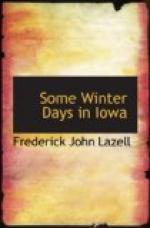Mr. Blue Jay sat in a clump of dogwood, doing nothing. He was not so tame as the others and yet he permitted a twenty-foot view of his blue-gray coat, his aristocratic crest, his dusky white vest, his white-tipped tail and the black band across the back of his head, down the neck and across the breast—like a black collar worn very low down. It was a spring-like morning, the thermometer rapidly rising toward forty-five, and Mr. Blue Jay was in one of his imitative moods. There is hardly a limit to his vocabulary, and it would not be surprising if some of his imitative stunts should be mistaken for the call of an early robin. Among these calls is a liquid gurgle, like hard cider coming out of the neck of a big brown jug. Another, and a common one, is two slurred eighth notes, repeated, “sol te, sol te”—upper G and B in the key of C.
Meanwhile the woods had been resounding with the lively tattoo of the woodpecker, and finally Downy was found at the top of a dead dry elm, busily doing this reveille, fast and loud as the roll of a snare drum. His head was going so fast that it looked like a quick series of heads and the tree rattled so it could be heard afar. Most writers regard this as the woodpecker’s love call, a sign of spring, as it were—but Downy is usually heard and seen doing it on warm days every month in the winter. The females are seen at it almost as often as the males; the latter are known by the scarlet band at the back of the head. Perhaps it is not a love call after all; it may be only the exuberance of spirits caused by a fine breakfast and a warm morning.
Downy kept it up, heedless of the human observer. But when a red squirrel ran up the tree to within four feet of the spot chosen for a sounding board, Downy suddenly left. The squirrel sat in the sunshine and smoothed his fur with his nose and his paws, like a cat.
Two big hairy woodpeckers were on a neighboring tree, but they were not so fearless. One can hardly get nearer than thirty feet. The field glass is a great help in such cases, and no one should go to the woods without one, or at least a good opera glass. These two were both males. That could be easily told by the bright scarlet band on the back of their heads. The rest of the plumage is much like the downy woodpecker. Both have beautiful black wings, spotted and striped with white and a broad white stripe down the back. Downy’s white outer tail-feathers are barred with black; the Hairy’s are all white. Downy is sparrow-size; Hairy is robin-size. Downy is usually a gentle creature; Hairy is aggressive and militant. Downy is a little Lord Fauntleroy; Hairy is a Robin Hood.
One other woodpecker was seen on this lucky bird-day. It was the red-bellied woodpecker, more rare and more shy than either of the others. His breast is a grayish white tinged with red, and his back is barred white and black like a ladder; but the black is not so deep and vivid as that of the other woodpeckers. He has no white stripe down the middle of his back. His nape and crest are both scarlet and he utters a hoarser squeak than either the downy or the hairy.




